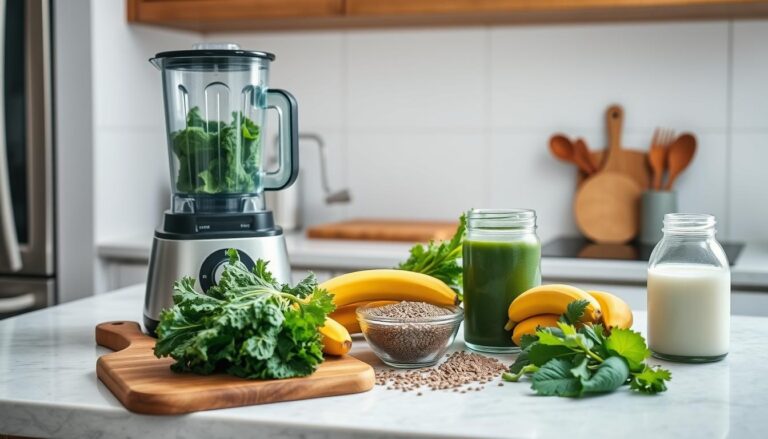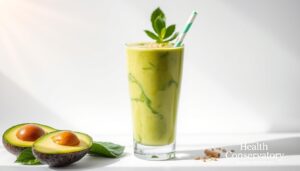Can a thick, spoonable breakfast really meet your vegan protein goals without turning runny?
You’ll learn how a dense fruit base, blended with minimal unsweetened almond milk, keeps texture spoonable while boosting protein totals. Frozen berries and banana gave the base body, while Truvani Plant-Based Protein (pea, pumpkin seed, sunflower seed) provided an organic, no-added-sugar lift.
Practical tips include using a high-speed blender, being patient while blending, and choosing toppings like fresh berries, granola, sliced almonds, coconut, nut butter, chia, flax, and hemp to nudge macros without many extra calories.
One example base delivered about 203 kcal and 15 g protein before toppings. You’ll get a simple recipe, a realistic prep time in minutes, and gear notes so you can make this for weekday breakfast. Try the smoothie generator to plan combos and save favorites: https://healthconservatory.com/smoothie-generator.
Key Takeaways
- Vegan bowls can reach meaningful protein with plant powders and seeds.
- Frozen fruit and minimal liquid keep the base thick and spoonable.
- Truvani is a quality organic option without added sweeteners.
- Toppings add texture and can raise protein without many extra calories.
- A high-speed blender and patience make the best consistency.
How Much Protein in a Smoothie Bowl: quick answer for vegans
A quick, practical answer for vegan readers: most plant-based spoonable bowls land around 15–25 grams per serving when you add one level scoop of plant protein and keep liquids low.
What affects your total: the amount of protein powder you use, seeds, and any nut or seed butter you drizzle on top. A lean base with frozen fruit and just enough almond milk to blend yielded roughly 203 calories and about 15 g protein before toppings.
To hit higher targets, add a full scoop of vanilla protein powder and 1–2 tablespoons of chia seeds or a tablespoon of peanut or almond butter. That often pushes bowls into the 20–30 g range without blowing calories.
Your tracking checklist
- Read the protein grams per scoop on your powder label.
- Add grams from chia seeds, hemp, and nut butter.
- Log each serving or use our smoothie generator to set target grams and build repeatable combos: https://healthconservatory.com/smoothie-generator.
“Keep milk slow and frozen fruit high — texture and macros both win.”
Vegan protein math for smoothie bowls

Stacking concentrated protein sources lets you keep frozen fruit high and liquid low for a thick, spoonable bowl.
Ingredient protein cheat sheet: use this to add precise grams. Most vegan protein powder scoops deliver ~20–25 g. Two tablespoons chia seeds add ~5 g. Three tablespoons hemp seeds add ~10 g. Two tablespoons peanut butter add ~7–8 g. Two tablespoons almond butter add ~6–7 g. One cup unsweetened almond milk adds ~1 g.
Build to your goal
20 g: small scoop (~15–18 g) + 2 tbsp chia seeds; 1 cup frozen berries + ½ banana keeps body without too much sugar.
30 g: full scoop (~20–25 g) + 1 tbsp peanut butter + 1 tbsp chia, or swap peanut for hemp to keep texture lighter.
40 g: hefty scoop + 3 tbsp hemp seeds + 1 tbsp almond butter; blend with almond milk by tablespoons so the mixture stays very thick.
Smart swaps and tips
- Use vanilla to mask greens and keep flavor consistent.
- Pumpkin seed protein blends well if you avoid pea or soy.
- Add liquid in tbsp increments and stop to scrape to protect texture.
| Ingredient | Portion | Protein (g) | Note |
|---|---|---|---|
| Vegan protein powder (vanilla) | 1 scoop | 20–25 | Anchor flavor; blends with berries and banana |
| Chia seeds | 2 tbsp | ~5 | Thickens and adds fiber |
| Hemp seeds | 3 tbsp | ~10 | High protein, light texture |
| Unsweetened almond milk | 1 cup | ~1 | Use sparingly to keep spoonable |
“Measure by tbsp and cup, then record grams so you can repeat wins.”
Recipe: High-Protein Berry Smoothie Bowl (Vegan)
This simple recipe uses frozen mixed berries and a scoop of vanilla protein to make a thick, spoonable berry bowl in minutes.
Ingredients
- 1 cup frozen mixed berries (cup frozen)
- 1/2 medium banana (plus extra bananas for topping)
- 1 full scoop plant vanilla protein powder
- 1/4–1/2 cup unsweetened almond milk, added slowly
- 1–2 tbsp chia seeds or 2–3 tbsp hemp seeds
Directions
- Add frozen mixed berries, banana, vanilla protein powder, and seeds to the blender.
- Start with a small splash of almond milk, then pulse and blender blend smooth until very thick.
- Stop to scrape the sides if blades stall. Add almond milk 1–2 tbsp at a time to control texture.
- Pour into a bowl and level with the back of a spoon for even toppings.
Toppings and serving
Choose 2–4: fresh berries, vegan granola, coconut flakes, extra chia seeds, sliced almonds, or peanut/almond butter. Measure portions to match your target serving macros.
“Use frozen fruit for thickness and add liquid slowly to keep the base spoonable.”
| Item | Portion | Protein est. (g) |
|---|---|---|
| Plant vanilla protein powder | 1 scoop | 20–25 |
| Chia seeds | 1–2 tbsp | ~3–5 |
| Hemp seeds | 2–3 tbsp | ~6–10 |
| Unsweetened almond milk | 1/4–1/2 cup | ~0.5–1 |
Prep and total time: about 5 minutes once ingredients are ready. The base without toppings was roughly 203 kcal and ~15 g protein in our example. For instant variations and to set your protein target, use the smoothie generator: https://healthconservatory.com/smoothie-generator.
Optimize flavor, texture, and nutrition in your smoothie bowl
Small changes—less milk, more frozen fruit, a top-shelf plant powder—fix most texture and flavor issues fast.
Pick the right powder. Choose a plant-based vanilla protein powder that blends smooth and tastes good. Truvani-style blends (pea, pumpkin seed, sunflower seed) avoid chalkiness and keep flavor clean.
Control thickness by adding almond milk sparingly. Start with a tablespoon or two and add in small amounts until the mix reaches spoonable texture. Frozen fruit builds cold body quickly and saves you from over-thinning.
Practical steps you can use in minutes
- Pulse frozen pieces in your blender, then blend smooth; stop to scrape the sides so everything moves evenly.
- If flavors seem flat, add a pinch of salt and a tiny extra splash of vanilla.
- Boost nutrition with seeds or a small swirl of almond butter for healthy fat and extra protein without making the bowl oily.
- Top intentionally: a sprinkle of coconut or granola and fresh berries add crunch and contrast.
“Pre-portion fruit and powder into freezer packs to save time and get consistent results.”
| Goal | Quick tweak | Why it works |
|---|---|---|
| Thicker texture | More frozen fruit, less milk | Cold solids create body and keep the bowl spoonable |
| Better flavor | Higher-quality vanilla powder, pinch of salt | Reduces chalkiness and brightens berries |
| Higher nutrition | Seeds or 1 tbsp nut butter | Adds protein and fat for satiety without excess oil |
Conclusion
Small, consistent choices — seed swaps, measured powder, and minimal milk — let you build repeatable, spoonable berry bowls.
Keep it simple: start with frozen mixed fruit and banana, add one reliable scoop of plant powder, then layer chia or hemp and a measured spoon of nut butter to meet your grams goal. Measure by cup and tbsp so servings stay consistent across time.
Choose vanilla protein or blends with pumpkin seed for better flavor and less chalk. For texture, add milk in tablespoons and use the pulse-stop method to blender blend smooth.
Ready to customize? Set targets and generate recipes in minutes at https://healthconservatory.com/smoothie-generator.




